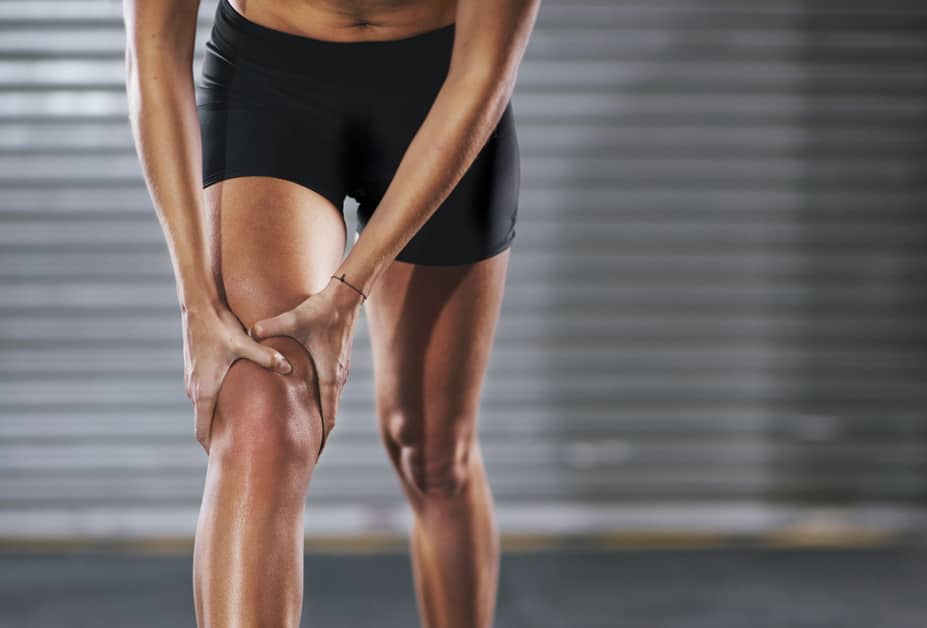Warm Up
Warming up is vital for any physical activity. Especially to decrease the potential of knee pain. Before you start, it’s essential to heat up your body. This can include stretches, light jogging, or bodyweight exercises. Warming up gets the blood flowing to the muscles. This prepares the body for exercise better and minimizes the possibility of knee pain during the workout.
Stretch your muscles
Stretching is key in warming up. It lubricates your joints, soothes and relaxes your muscles, and increases flexibility. Before any exercise, spend a few minutes stretching your quadriceps, hamstrings, and calves. Don’t forget your glutes – they’ll be put to work during exercise.
Do stretches for 10-30 seconds, pay attention to each muscle, and listen to what your body is saying. If an area starts tugging instead of lengthening, it’s time to stop before an injury occurs. Take slow breaths through the nose while stretching – don’t hold your breath, or your muscles will tense up.
Do dynamic warm-up exercises
Dynamic warm-up exercises are great! They get your heart rate going, make your joints looser, and improve balance and coordination. It’s important to start your exercise routine with this type of warm-up. Examples are squats with arm swings, lunges with torso rotations, and high knee toe touches.
Do 10-20 reps on each side. Focus on form, posture, balance, and controlled movement. This helps prevent knee pain too, as it strengthens muscles around the joint and encourages good firing patterns.
Do dynamic warm-up exercises at least 3 times a week before activities that strain your knees – like running or jumping. It also improves flexibility and range of motion in your hips and legs, making your performance better.
Exercise Properly
Beginners: start exercising! It is key to avoid knee pain. To do this, warm up muscles before exercising and stretch out joints, muscles and tendons. Exercise in a way that is safe and effective.
In this article, we will explore the advantages of following these tips and how to do it right:
Stick to low-impact exercises
Low-impact exercises are activities that involve minimal strain on your joints, bones, and muscles. They can be useful for those who have had an injury, or those at risk of getting one. Examples are cycling, swimming, yoga, pilates, and walking.
Before starting, warm-up with stretching and light cardio. This helps the body prepare for physical activity by improving circulation and increasing flexibility around your joint. It also reduces the chances of muscle strain or pulls.
Benefits of low-impact exercises include:
- Better endurance without extra stress on knee and hip joints. This can help reduce joint pain due to arthritis.
- Boosting fitness levels, energy, and decreasing stress, making you feel better mentally and physically.
Choose the right shoes
Selecting the perfect shoes is critical for avoiding knee pain during physical activity. Rubber soles and cushioning that supports your feet in running shoes can help decrease the strain on your knees. They also cushion the impact when you jump, walk or run, preventing further harm to your joints.
When you buy running shoes, make sure they fit well. Your heel should fit snugly at the back of the shoe and your toes should move easily. Get professionally fitted in a store that specializes in running shoes. The salesperson can determine what type of shoe is best for your sport or activity and could find a comfy, supportive pair that fits you perfectly.
Apart from picking a suitable shoe style and size, think about using heel lifts if needed. Heel lifts are meant to equalize the leg length on both sides of your body or decrease tension on other body parts such as ankles, knees, hips and lower back caused by quadriceps tendonitis or patellar tendonitis (jumper’s knee). Consult a medical expert prior to trying a heel lift to make sure it’s safe for you and use one that has the right cushioning for more shock absorption if needed.
Adjust your posture
Keep your feet shoulder-width apart when exercising. Weight should be evenly distributed. Stand with a neutral spine, head and chin up. Engage your abdominal muscles to keep balance. When doing squats or lunges, sit back rather than pushing forward. Get out of seated position using both legs. Take breaks between sets and stay hydrated. This will help minimize knee pain.
Prevention Strategies
Achieving pain-free knees while exercising is key. To do this, use correct form and alignment to prevent strain and injury. Also, it’s a good idea to know which exercises will help strengthen the knee.
Here we’ll explain the strategies for avoiding knee pain when exercising:
Strengthen the muscles around your knees
Strengthening the muscles around your knees is key to avoiding knee pain. Weak muscles and bad alignment may cause more pressure on the knee joint which leads to aches. So, it is vital to boost the power and coordination of the muscles that cross the knee joint. This includes the quadriceps and hamstrings at the front of the thigh and calf muscles at the back of the leg.
To help strengthen these spots, it’s essential to perform a regular exercise program with some light weight training or resistance exercises that focus on particular muscle groups. This will help reduce strain on your knees during physical activity or everyday life activities.
Moreover, simple exercises like one-legged balance work or single-leg squats can help improve muscle strength and balance around your joints. Practicing stretching before physical activity will also reduce stiffness and tension in the knee joint muscles.
Increase your flexibility
Flexibility is key for avoiding knee pain. Muscles that are flexible are less likely to strain and tighten during exercise, resulting in less force on the knee joint and less pain. Taking time to stretch before and after a workout helps keep muscles flexible, so you’re less likely to feel pain.
If you’re not very flexible to begin with, start slowly. Begin by doing a few simple dynamic stretches during your warm-up. Static stretches, which involve holding a pose for a period of time, should be part of your cool-down routine.
- Dynamic stretches can be walking lunges, standing side bends and hip circles.
- ROM (range-of-motion) exercises such as squats, calf raises and gentle twists are great for static stretching.
With time, longer stretching bouts will help even more with flexibility. They’ll also help reduce post-exercise soreness and reduce tension throughout the body.
Take breaks between sets
For proper recovery and to avoid injury, it’s essential to take breaks between sets while working out. Having breaks is a major part of any exercise routine. They help reduce the danger of overtraining injuries, as they give your muscles time to rest and manage inflammation caused by exercise. Breaks also help combat exhaustion, so you can reach optimum performance during each set.
How many breaks you need depends on various factors such as exercise duration and intensity, workout goals, and fitness level. Tune into your body – if you find it difficult to go through another set without a break, it’s time for one. Generally, the breaks should not exceed 90 seconds to get the best results. Taking longer than five minutes between sets won’t give any advantage and can lead to decreased muscle activation if you wait too long.
Whenever possible, start with a low-intensity warm-up and then gradually increase intensity until reaching peak performance for that particular muscle group or activity.
Recovery
To prevent knee pain, recovery is key. Physical and mental practices are essential to reduce inflammation and repair knee tissues. Here are recovery strategies to use when exercising:
- Focus on both physical and mental recovery. This will help reduce inflammation and improve tissue repair.
- Doing this can help stop knee pain during physical activities.
Ice your knees
Icing your knees is key to recovery. It reduces swelling and inflammation that exercising can cause. To ice them, put small towel-wrapped ice packs on the area for 15-20 minutes. Do this several times a day. Don’t put ice directly on the skin. Use a towel or barrier. If you don’t have access to ice packs, use a bag of frozen veggies like peas, corn or carrots.
Anti-inflammatory meds like ibuprofen can help too. But, check with a doctor first.
Use a foam roller
Foam rollers are great for recovery and injury prevention. They work by applying pressure to the soft tissues and increase blood flow. This kneads out muscle tension and creates a relaxing massage sensation. Foam rollers are versatile and can be used on neck, shoulders, arms, legs and back.
To get the most out of self-myofascial release, use slow rolling movements. Quick or harsh action can increase tension, instead of releasing it.
Try physical therapy
Physical therapy is a great way to keep knee pain away. It can offer you exercises and treatments that strengthen the muscles around your knee and give it back its range of motion.
Your physical therapist can use special equipment and teach you the right exercises. This could be leg, hip, buttock, quads, and hamstring exercises. Stretching can also help by giving your affected area more flexibility and taking away strain in other parts of your body which are connected to joint inflammation or overexertion.
Your physical therapist may also use massage and stretching techniques to get rid of tension. Cold or hot packs, braces, and taping techniques can give you extra support when doing exercises. You may also need to make changes to your lifestyle, like changing your diet or cutting back on activities that make your knee hurt.
Frequently Asked Questions
Q1: What are some tips for preventing knee pain during exercise?
A1: To help prevent knee pain during exercise, it is important to warm up and cool down properly. It is also important to use proper form when exercising, and to not push your body too hard. Additionally, you should use the right type of exercise for your body type, and wear comfortable and supportive clothing and shoes.
Q2: What type of exercise is best for reducing knee pain?
A2: Low-impact exercises such as swimming, biking, and walking are generally best for reducing knee pain. These activities are less likely to cause additional strain on your knees than high-impact activities like running.
Q3: How do I know if I’m pushing myself too hard during exercise?
A3: If you are feeling pain or discomfort while exercising, it is important to take a break and listen to your body. If the pain persists, it is best to stop and consult a doctor. Additionally, if you feel like you are pushing yourself too hard, it may be best to take a break and reduce the intensity of your workout.





